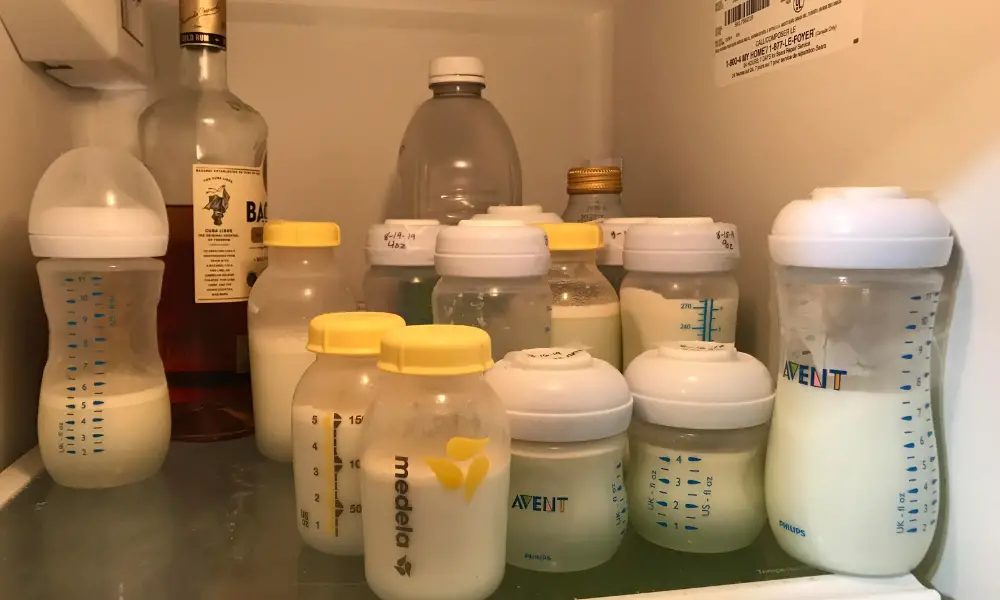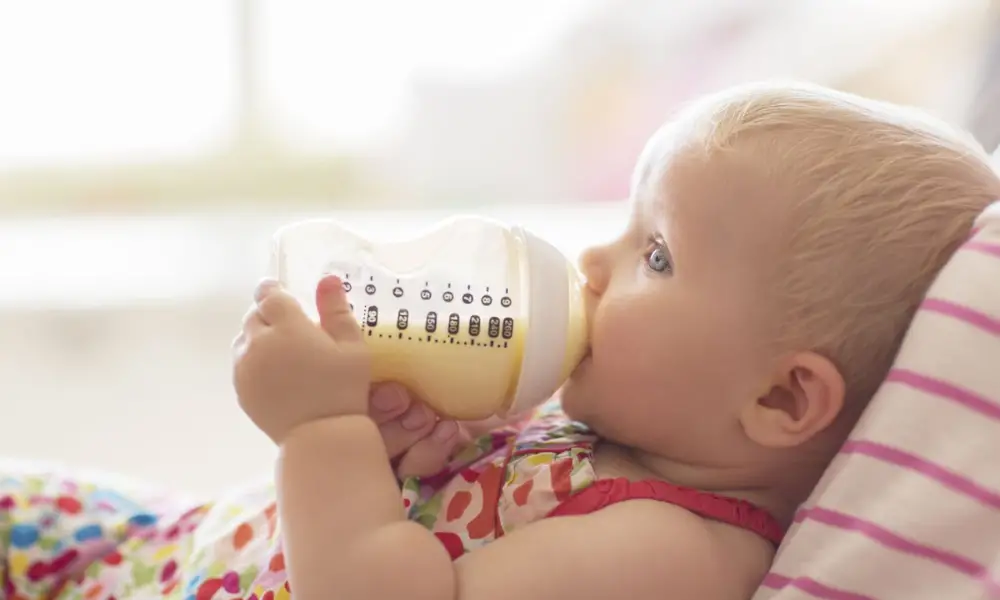You can always have milk on hand for your baby when you safely store your breast milk. Breast milk can be kept for a few days in the fridge or frozen for months at a time. Glass jars, BPA-free clear plastic containers, or bags made expressly for storing milk can all be used to store milk.
One of the best presents you can offer your kid is breast milk. For this reason, you want to be sure you’re storing and using the milk properly because you devote much of yourself to pumping it for your baby. For this reason, you pump at lunchtime or in the middle of the night and cry over spilled (or ruined) milk.

How Long can I Freeze Breast Milk?
You may store milk for longer periods by freezing it. However, it’s crucial to consider the sort of freezer you’re using and the location where you’ll keep your milk. Frozen milk can be kept in a refrigerator freezer compartment for three to four months with a separate freezer door. In a deep freezer from the refrigerator, exposed breast milk can be kept for up to six months. You can only store frozen milk for up to two weeks if your freezer door occupies your refrigerator’s space.
The location of the milk containers in your freezer is one item to consider. Breast milk shouldn’t be kept in the freezer door rack. When the freezer door is opened and closed, milk within is subjected to significant temperature variations. Storing milk farther back and away from the door is advisable to prevent these temperature variations.
What is the Correct Method of Freezing Breast Milk?
In just six simple steps, you can correctly freeze breast milk and use it for up to a year.
The Storage Container of your Choice
Breast milk can be kept in various containers, such as glass jars, plastic bottles, storage bags, and breast milk trays.
To prevent leaks and contamination, disposable bottle liners used for freezing breast milk may need additional protection. Glass offers the best protection for freezing breast milk in tougher containers since it is the least absorbent material. Whichever container you decide on, it ought to be sanitary, BPA-free, and suitable for storing food.
Assemble your Tools and Supplies
All you need is a spotless collection container if you express your breast milk manually. Get your pump, pump flanges, tubing, and collection container ready if you plan to pump.
To stop bacteria from entering your breast milk as you pump, ensure that all your pumping supplies are clean and dry. You might need to prepare extra collecting containers, depending on how much breast milk you can pump.
Wash your Breasts and Hands
Before you start to express or pump your breast milk, cleanse your hands and your breasts. While collecting breast milk, any bacteria on your skin could enter. By keeping things as clean as possible, you can reduce infection in the best way possible.
Inject or Express Mother’s Milk
You should pump for around 10 minutes on each side, then collect the milk. Avoid filling it to the top if you use the same collection container as your storage container. Remove the bottle from the pump and swap it out for another one after your breast milk has filled it to about 2/3 to 3/4 of the way.
If you are transferring breast milk from one storage container to another, finish collecting your milk first. Then, transfer the milk to the storage containers.
Lock Up your Container
When utilizing a storage bag, be careful to properly and securely seal the bag. Use a solid one-piece screw-on cap for the best seal when using a glass or plastic bottle. Breast milk should never be frozen using bottle nipples as a lid.
Incorporate the Container into the Freezer
Label your breast milk with the date and time it was collected and store it in the freezer as soon as possible. Depending on the kind of freezer you have, you can preserve breast milk for a variety of times:
Breast milk can be frozen for two weeks in a refrigerator’s internal freezer.
Breast milk can be frozen in a standalone deep freezer for a year.
For up to six months, pumped breast milk can be stored in a normal freezer that is a part of a side-by-side or top-and-bottom refrigerator-freezer combination with separate doors. Although most freezers reach this temperature, you should still purchase a cheap freezer thermometer to give yourself peace of mind. Set yours so that your ice cream becomes firm.
Which Containers are Considered Best for Storing Breast Milk?
Depending on your lifestyle and preferences, you have a few options to consider:
Milk storage bags – Specially-made milk bags are the most common ones. Our Breast Milk Storage Bags work with all well-known brands of breast pumps and are simple to use transport, store, and keep warm. They are affordable and don’t take up a lot of space in the refrigerator or freezer.
The Cleveland Clinic advises using glass containers since they maintain breast milk’s components the best. However, some childcare facilities won’t take glass containers because they can break easily.
Plastic bottles or containers – Hard-sided, clear plastic containers are also an option, such as the bottles that frequently come with two electric pumps. They won’t likely break and are reusable bottles. However, purchasing all the bottles required to preserve your milk might be expensive.
Double-bag your milk to prevent any milk from leaking if the original bag is destroyed in the freezer. Some parents keep a few milk storage bags in a larger storage bag.
How do I Defrost Milk and Heat it?
Run the milk under warm running water for a few minutes to begin thawing or heating it. The container can alternatively be agitated in a bowl of warm water. Test the milk’s temperature once warmed up by drizzling a few drops on your wrist. Giving your warm kid milk is acceptable if it’s not hot. Before feeding it to your infant, wait until it has cooled off if it is hot to the touch. Although they may not appreciate it, babies can still consume milk that is cold or at room temperature.
Breast milk shouldn’t be heated in a microwave. A microwave can burn your infant since it doesn’t heat breast milk uniformly. This way of boiling the milk can destroy important proteins and vitamins. If heated for an extended period, it may occasionally cause the bottle to explode.
It would be best if you didn’t heat a milk bag or container on the stove. Instead, warm the water in the pan on the stove, take it off the heat, and then submerge the container in it. Keep the milk from being heated or brought to a boiling point. High heating may cause some nutrients in the milk to be depleted.
How to Determine When Not to Use Stored Breast Milk?
Determining whether breast milk has gone sour is not always simple. When food is frozen, most things alter. According to Morgan-Vaughn, “you might realise it has a distinct smell than what you’re used to.” This is typical.
She continues, “What you ate the day you pumped affects how your milk smells. Most babies will consume the milk because it is safe. A small percentage of mothers detect a soapy, metallic, or rotten smell in their milk. “A high concentration of lipase, an enzyme in all milk, is the cause of this [soapy fragrance].
Different treatments exist for chemical oxidation and high lipase. Chemical oxidation may be to blame for milk that smells metallic or sour after heating or storage. Both kinds of milk are okay to give to your infant, but if they object to the flavor difference, spend some time learning how to handle it.
Still uncertain? “Don’t feed your kid anything that has freezer burn, tastes sour, or has freezer burn.” Toss it out if you’re unsure, advises Morgan-Vaughn.
Can Breast Milk be Frozen if it Sitting Outside the Freezer?
Milk can be kept in the refrigerator for three to five days and then transferred to the freezer at any time. But it’s better to freeze milk as soon as possible, ideally within the first three days, to preserve most nutrients. Keep your milk at the back of the refrigerator to avoid temperature changes brought on by opening and closing the door.
What Happens if you Give Spoilt Breast Milk to your Baby?
Spoilt milk may cause a baby to express and communicate pain in their behavior. When trying to give the baby milk, a watchful mother might detect the baby wriggling or spitting out the milk and be able to check before the baby consumes much of the milk.
Any parent, guardian, or caregiver who observes the infant wriggling or refusing milk should cease feeding it to them right away.
Although the infant may swallow the breast milk, spoilt breast milk can upset the baby’s stomach. The infant’s restlessness, constant crying, and vomiting would most likely draw the mother’s attention to this.
Typically, the youngster should be expected to vomit up the tainted milk. It is rare for infants to experience diarrhea or fever after consuming tainted milk, though.
Let the infant completely spit out traces of the tainted milk once they vomit it. To ensure that the infant’s stomach is properly positioned, hold it upright and gently pat its back.
They should feel more at ease and soothed as a result. Dehydration might result from symptoms that persist or from vomiting. Contacting your pediatrician is a good idea if the vomiting persists or you are uncertain and concerned.
According to Dr. Amin, a variety of factors, including how much was consumed and the condition of the spoiled milk, can affect how quickly a baby becomes ill after consuming spoiled breast milk. If your baby becomes ill due to tainted breast milk, they suffer from food poisoning. You might want to call your doctor or keep an eye out for symptoms at home, depending on the dosage.
Respondents claim that “contaminated” breast milk is not given to nursing infants. It is important to pay attention to this hazardous activity. Third, the connection between open defecation, inadequate hygiene, and diarrhea deserves an introduction or explanation. Finally, diarrhea caused by exposed feet or curses is a generally benign condition that doesn’t require routine treatment. To guarantee that a better understanding of the causes of diarrhea translates into a better understanding of diarrhea prevention, additional research that supports communication and social mobilization tactics building on these findings is needed.
Conclusion
If you want to freeze your breast milk, it is important to use freezer-safe containers. It would be best to clean the containers in hot soapy water and dry them thoroughly. You should also thaw your milk before freezing it. It must be stored near the back of the refrigerator to store it for future use.
Breast milk can be stored at room temperature for up to two hours or in the refrigerator for up to four days. The refrigerator temperature should be between 32 and 39 degrees Fahrenheit. It is best to use the milk within four days. If you need to keep it longer, it can be stored in the freezer for up to 12 months.

